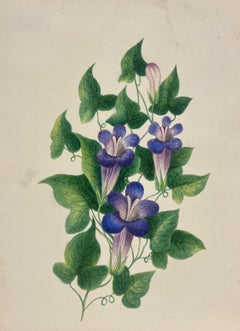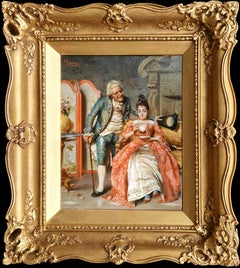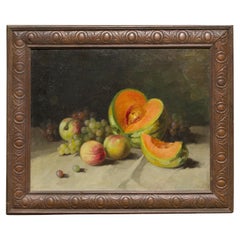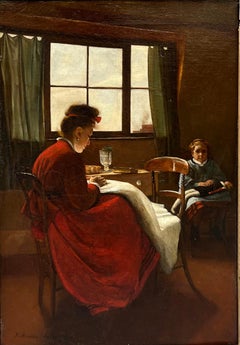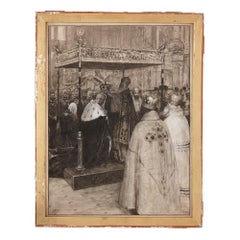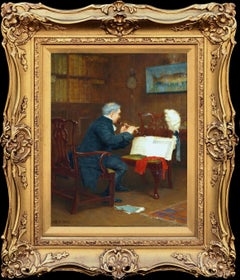19th Century Interior Paintings
to
52
110
73
92
54
61
Overall Width
to
Overall Height
to
77
390
2,010
5,221
33
43
62
104
83
124
146
160
125
109
44
34
8
5
3
2
1
1
206
176
6
289
214
120
116
50
35
22
21
19
16
16
15
15
14
14
13
12
12
12
10
384
358
158
155
49
4
3
3
3
2
309
12
277
112
Period: 19th Century
Botanical Watercolour Painting of Purple Trumpet Flowers with Lush Green Foliage
Located in Cirencester, Gloucestershire
Purple Trumpet Flowers
watercolour drawing on artist paper, unframed
drawing: 8.5 x 6.5 inches
Provenance: Private collection
Condition: Great condition
Description: This elegant b...
Category
English School 19th Century Interior Paintings
Materials
Watercolor
The Admirer
By Pompeo Massani
Located in Belgravia, London, London
Oil on canvas
Canvas size: 12 x 9 inches
Framed size: 19 x 15.75 inches
Signed upper left
Category
19th Century Interior Paintings
Materials
Canvas, Oil
$12,881
19th Century French Signed Still Life
By E.A. Baron Deslandes
Located in Roma, IT
Important painting "Still life" oil on canvas of the second half of the 800 by the great artist Aémile-Auguste Vivier-Deslandes called "Baron Deslandes".
Of rare intensity and beauty...
Category
French School 19th Century Interior Paintings
Materials
Canvas, Oil
Interior scene - Woman and child
Located in PARIS, FR
François Bonvin (1817 - 1887)
Interior scene - Woman and child
1871
Signed, dated and located lower right (London)
Oil on canvas
48,2 x 33,2 cm (63 x 48 cm with frame)
Category
19th Century Interior Paintings
Materials
Canvas, Oil
Russian watercolour of the coronation of a Tsar
Located in London, GB
Russian watercolour of the coronation of a Tsar
Russian, late 19th Century
Frame: Height 39cm, width 30cm, depth 0.5cm
Sheet: Height 36cm, width 2...
Category
19th Century Interior Paintings
Materials
Watercolor
The Recital
Located in Belgravia, London, London
Oil on canvas
Canvas size: 12 x 10 inches
Framed size: 18.25 x 16 inches
Signed lower left
Category
19th Century Interior Paintings
Materials
Canvas, Oil
$10,894
A Woeful Companion
By Arthur Batt
Located in Belgravia, London, London
Oil on canvas
Canvas size: 27 x 24 inches
Framed size: 33 x 30.5 inches
Signed and date '87 lower left
Category
19th Century Interior Paintings
Materials
Canvas, Oil
Portrait Of A German Pinscher, 19th Century EDWARD AISTROP (1880-1920) Circa 1
Located in Blackwater, GB
Portrait Of A German Pinscher, 19th Century
EDWARD AISTROP (1880-1920)
Circa 1900 portrait of the head of a German Pinscher, oil on board by Edward Airstrip. Important early depict...
Category
19th Century Interior Paintings
Materials
Oil, Board
$1,870 Sale Price
35% Off
Pair of French Neoclassical oil paintings by Dubost
By Antoine Dubost
Located in London, GB
Pair of French Neoclassical oil paintings by Dubost
French, 1809/11
Frame: Height 70.5cm, width 86cm, depth 9cm
Panel: Height 45cm, width 61c...
Category
Baroque 19th Century Interior Paintings
Materials
Oil, Panel
19th Century historical genre oil painting of a lady & her physician
By Casimir van den Daele
Located in Nr Broadway, Worcestershire
Casimir van den Daele
Belgian, (1818-1880)
On the Mend
Oil on panel, signed & dated 1857
Image size: 29 inches x 21.5 inches
Size including frame: 35.5 inches x 28 inches
Casimir ...
Category
19th Century Interior Paintings
Materials
Oil, Panel
Antique watercolour of Palazzo Signoria in Florence
By A. Marrani
Located in London, GB
This beautiful view of a Florentine courtyard was painted by A. Marrani, an artist who, in the late 19th Century, painted many views of the Tuscan city. The cortile (‘courtyard’) sho...
Category
Naturalistic 19th Century Interior Paintings
Materials
Paper, Watercolor, Board
A Friendly Game Spring day in England Original Oil Painting Walter Dendy Sadler
Located in Soquel, CA
A Friendly Game Spring day in England Original Oil Painting Walter Dendy Sadler
Jovial companions enjoy a game of cards by Walter Dendy Sadler,.RA...
Category
Barbizon School 19th Century Interior Paintings
Materials
Oil, Illustration Board
The Dressing Room
Located in Belgravia, London, London
Oil on panel
Panel size: 14 x 11 inches
Signed lower right
Category
19th Century Interior Paintings
Materials
Oil, Panel
Eduardo León Garrido, "An Elegant Dance", 19th C. Oil on Mahogany Wood Panel
Located in Madrid, ES
EDUARDO LEÓN GARRIDO
Spanish, 1856- 1949
AN ELEGANT DANCE
signed "E. L Garrido" (lower right)
oil on mahogany wood panel
25-1/8 x 32 inches (63.5 x 81 cm.)
framed: 31 x 38 inches (78.5 x 96 cm.)
PROVENANCE
Private Spanish Collector
Eduardo León Garrido (Madrid, 1856 - Caen, 1949) was a Spanish painter. He began his training at the Higher School of Painting in Madrid and as a disciple in Vicente...
Category
Realist 19th Century Interior Paintings
Materials
Oil, Wood Panel
After Dinner Rest Awhile - Quintessentially British Domestic Scene
Located in London, GB
Margaret Dovaston (1884–1955)
After Dinner, Rest Awhile
Oil on Canvas
Signed M Dovaston (lower right)
46 x 61 cms / 18 x 24 inches
This finely detailed scene by British artist Marga...
Category
Academic 19th Century Interior Paintings
Materials
Canvas, Oil
Italian oil on canvas painting of a lacemaker by Paoletti
Located in London, GB
Italian oil on canvas painting of a lacemaker by Paoletti
Italian, late 19th Century
Frame: Height 119cm, width 93cm, depth 5cm
Canvas: Height 101cm, width 76cm
This beautiful paint...
Category
19th Century Interior Paintings
Materials
Canvas, Oil
RINGEL Belgian painting Realist school Workshop Painter 19th
Located in PARIS, FR
Frédéric RINGEL
Barmen (Germany), 1826 – 1907
The Painter in his Studio
Oil on canvas
33 x 24 cm (60 x 51.5 cm with frame)
Signed on the lower right side "F. Ringel"
Very fine 19th-c...
Category
Realist 19th Century Interior Paintings
Materials
Oil
Pair of 19' century Chinese Reverse-Painted Mirror Pictures
Located in Rome, IT
A pair of Chinese reverse glass painting representing women and a child in a garden pavillion. Original "Chinese Chippendale" framing.
China for export, circa 1830.
Category
Qing 19th Century Interior Paintings
Materials
Mirror, Paint
Portrait of an Elegant Lady 1897
Located in Saint-Ouen, FR
GENTY Emmanuel (1830-1904)
Portrait of an Elegant Lady
Oil on canvas signed low right and dated 1897
Old Frame regilded with gold leaves
Dim canvas : 100 x 81 cm
Dim frame : 120 x 10...
Category
Academic 19th Century Interior Paintings
Materials
Oil
“Waiting for his Arrival” Oil on panel, Signed
Located in Jacksonville, FL
The painting is signed and dated 1872 in Algiers
Description:
Ferdinand Victor Léon Roybet (1840-1920) was a French painter renowned for...
Category
Academic 19th Century Interior Paintings
Materials
Oil, Panel
1900's French Impressionist Oil Painting Portrait of Elderly Lady in Mirror
Located in Cirencester, Gloucestershire
Portrait of an Elderly Lady, mirror behind
French Impressionist artist, late 19th/ early 20th century
extensively inscribed verso with details
oil on canvas
canvas: 22 x 18.5 inches
...
Category
Impressionist 19th Century Interior Paintings
Materials
Oil, Canvas
The first time model: the enigmatic young bohemian girl in traditional dress
Located in Norwich, GB
I love the feisty attitude of the girl depicted! With her hand on her hip, she seems to be saying to the artist: "Whatya looking at anyway?" She looks like she has a good head on he...
Category
Academic 19th Century Interior Paintings
Materials
Canvas, Oil
The Handsome Suitor
Located in Belgravia, London, London
Oil on canvas
Canvas size: 33.5 x 49 inches
Signed lower right
Category
19th Century Interior Paintings
Materials
Canvas, Oil
Still Life Bouquet with Calla Lilies and Amaryllis in Chinese Vase
Located in Soquel, CA
Elegant still life with calla lilies and amaryllis by an unknown artist. Completed in a classical style, two calla lilies and two amaryllis flowers sit in a vase with Chinese designs...
Category
Romantic 19th Century Interior Paintings
Materials
Canvas, Oil
Antique Gouache Painting Artist Studio Interior Painting 1870
Located in Douglas Manor, NY
3929 Antique interior painting of an artist studio works on artist board
Set in a period walnut frame image size 19.5x13.5"
Category
19th Century Interior Paintings
Materials
Watercolor, Gouache
Antique English Oil Painting Interior Scene "The Chess Match" 1890's
Located in Douglas Manor, NY
1666 Antique interior scene oil painting The Chess Match circa 1890's
Image size 19.5x 13.5"
Category
19th Century Interior Paintings
Materials
Oil, Canvas
Pair of 19' century Chinese Reverse-Painted Mirror Pictures
Located in Rome, IT
A pair of Chinese reverse glass painting representing women and a child in a garden pavillion. Original "Chinese Chippendale" framing.
China for expor...
Category
Qing 19th Century Interior Paintings
Materials
Mirror, Paint
Bouquet de fleurs dans une timbale posée sur la cheminée
Located in London, GB
Image dimensions: 46cm x 38cm
Framed dimensions: 62.5cm x 54.9cm
Signed lower left.
This beautiful original oil painting by Emile Mesnager depicts a bouquet of flowers in a tumbler...
Category
19th Century Interior Paintings
Materials
Oil, Panel
1930's Interior Still Life with Potted Plant and Draped Fabric on Ornate Chair
Located in Cirencester, Gloucestershire
Interior Still Life
Simone Forge 1930's French Impressionist
oil on board unframed
board: 9.5 x 7.5 inches
Provenance: private collection
Condition: great condition
For more any m...
Category
Impressionist 19th Century Interior Paintings
Materials
Oil
Interior Scene of a Woman in Black Gazing Out a Window
By William Verplank Birney
Located in Fort Washington, PA
An elegantly dressed woman sits gazing out of a window with a book on her lap. A fine example of the type of contemplative genre scenes for which Birney was well-known.
William Verp...
Category
19th Century Interior Paintings
Materials
Canvas, Oil
Painting 19th century old master rural daily life
By Henri-Joseph Castaing
Located in Saint-Ouen, FR
CASTAING Henri Joseph (1860-1918)
Young girl at the source
Oil on canvas signed low left
Frame gilded with gold leaves
Dim canvas : 100 X 66 cm
Dim frame : 121 X 86 cm
CASTAING Henr...
Category
Old Masters 19th Century Interior Paintings
Materials
Oil
Oil Painting by Robert Farrier "Pheobe the Millers Maid"
Located in Mere, GB
Oil Painting by Robert Farrier "Pheobe the Millers Maid" 1796- 1879. Farrier exhibited regularly at the Royal Academy and many of his works were engraved. Oil on panel. Labels Verso ...
Category
19th Century Interior Paintings
Materials
Oil
$1,644 Sale Price
22% Off
Lovers at the Fountain - Italian 19th Century Figurative Oil on Canvas Painting
Located in Rome, IT
Amanti alla Fontana - Lovers by a fountain, painting oil on canvas,
Signed left sight.
Measures: cm 70 x 100 frame 118 x 145
Faustini Modesto. Brescia, 27 maggio 1839 - Roma, 23 m...
Category
Romantic 19th Century Interior Paintings
Materials
Oil
Interior of a Japanese House
Located in New York, NY
Harry Humphrey Moore led a cosmopolitan lifestyle, dividing his time between Europe, New York City, and California. This globe-trotting painter was also active in Morocco, and most importantly, he was among the first generation of American artists to live and work in Japan, where he depicted temples, tombs, gardens, merchants, children, and Geisha girls. Praised by fellow painters such as Thomas Eakins, John Singer Sargent, and Jean-Léon Gérôme, Moore’s fame was attributed to his exotic subject matter, as well as to the “brilliant coloring, delicate brush work [sic] and the always present depth of feeling” that characterized his work (Eugene A. Hajdel, Harry H. Moore, American 19th Century: Collection of Information on Harry Humphrey Moore, 19th Century Artist, Based on His Scrap Book and Other Data [Jersey City, New Jersey: privately published, 1950], p. 8).
Born in New York City, Moore was the son of Captain George Humphrey, an affluent shipbuilder, and a descendant of the English painter, Ozias Humphrey (1742–1810). He became deaf at age three, and later went to special schools where he learned lip-reading and sign language. After developing an interest in art as a young boy, Moore studied painting with the portraitist Samuel Waugh in Philadelphia, where he met and became friendly with Eakins. He also received instruction from the painter Louis Bail in New Haven, Connecticut. In 1864, Moore attended classes at the Mark Hopkins Institute in San Francisco, and until 1907, he would visit the “City by the Bay” regularly.
In 1865, Moore went to Europe, spending time in Munich before traveling to Paris, where, in October 1866, he resumed his formal training in Gérôme’s atelier, drawing inspiration from his teacher’s emphasis on authentic detail and his taste for picturesque genre subjects. There, Moore worked alongside Eakins, who had mastered sign language in order to communicate with his friend. In March 1867, Moore enrolled at the prestigious École des Beaux-Arts, honing his drawing skills under the tutelage of Adolphe Yvon, among other leading French painters.
In December 1869, Moore traveled around Spain with Eakins and the Philadelphia engraver, William Sartain. In 1870, he went to Madrid, where he met the Spanish painters Mariano Fortuny and Martin Rico y Ortega. When Eakins and Sartain returned to Paris, Moore remained in Spain, painting depictions of Moorish life in cities such as Segovia and Granada and fraternizing with upper-crust society. In 1872, he married Isabella de Cistue, the well-connected daughter of Colonel Cistue of Saragossa, who was related to the Queen of Spain. For the next two-and-a-half years, the couple lived in Morocco, where Moore painted portraits, interiors, and streetscapes, often accompanied by an armed guard (courtesy of the Grand Sharif) when painting outdoors. (For this aspect of Moore’s oeuvre, see Gerald M. Ackerman, American Orientalists [Courbevoie, France: ACR Édition, 1994], pp. 135–39.) In 1873, he went to Rome, spending two years studying with Fortuny, whose lively technique, bright palette, and penchant for small-format genre scenes made a lasting impression on him. By this point in his career, Moore had emerged as a “rapid workman” who could “finish a picture of given size and containing a given subject quicker than most painters whose style is more simple and less exacting” (New York Times, as quoted in Hajdel, p. 23).
In 1874, Moore settled in New York City, maintaining a studio on East 14th Street, where he would remain until 1880. During these years, he participated intermittently in the annuals of the National Academy of Design in New York and the Pennsylvania Academy of the Fine Arts in Philadelphia, exhibiting Moorish subjects and views of Spain. A well-known figure in Bay Area art circles, Moore had a one-man show at the Snow & May Gallery in San Francisco in 1877, and a solo exhibition at the Bohemian Club, also in San Francisco, in 1880. Indeed, Moore fraternized with many members of the city’s cultural elite, including Katherine Birdsall Johnson (1834–1893), a philanthropist and art collector who owned The Captive (current location unknown), one of his Orientalist subjects. (Johnson’s ownership of The Captive was reported in L. K., “A Popular Paris Artist,” New York Times, July 23, 1893.) According to one contemporary account, Johnson invited Moore and his wife to accompany her on a trip to Japan in 1880 and they readily accepted. (For Johnson’s connection to Moore’s visit to Japan, see Emma Willard and Her Pupils; or, Fifty Years of Troy Female Seminary [New York: Mrs. Russell Sage, 1898]. Johnson’s bond with the Moores was obviously strong, evidenced by the fact that she left them $25,000.00 in her will, which was published in the San Francisco Call on December 10, 1893.) That Moore would be receptive to making the arduous voyage across the Pacific is understandable in view of his penchant for foreign motifs. Having opened its doors to trade with the West in 1854, and in the wake of Japan’s presence at the Philadelphia Centennial Exposition of 1876, American artists were becoming increasingly fascinated by what one commentator referred to as that “ideal dreamland of the poet” (L. K., “A Popular Paris Artist”).
Moore, who was in Japan during 1880–81, became one of the first American artists to travel to the “land of the rising sun,” preceded only by the illustrator, William Heime, who went there in 1851 in conjunction with the Japanese expedition of Commodore Matthew C. Perry; Edward Kern, a topographical artist and explorer who mapped the Japanese coast in 1855; and the Boston landscapist, Winckleworth Allan Gay, a resident of Japan from 1877 to 1880. More specifically, as William H. Gerdts has pointed out, Moore was the “first American painter to seriously address the appearance and mores of the Japanese people” (William H. Gerdts, American Artists in Japan, 1859–1925, exhib. cat. [New York: Hollis Taggart Galleries, 1996], p. 5).
During his sojourn in Nippon (which means, “The Land of the Rising Sun”), Moore spent time in locales such as Tokyo, Yokohama, Kyoto, Nikko, and Osaka, carefully observing the local citizenry, their manners and mode of dress, and the country’s distinctive architecture. Working on easily portable panels, he created about sixty scenes of daily life, among them this depiction of an interior of a dwelling. The location of the view is unknown, but the presence of a rustic rail fence demarcating a yard bordering a distant house flanked by tall trees, shrubs and some blossoming fruit trees, suggests that the work likely portrays a building in a city suburb or a small village.
In his book, Japanese Homes and Their Surroundings, Edward S. Morse (an American zoologist, orientalist, and “japanophile” who taught at Tokyo Imperial University from 1877 to 1879, and visited Japan again in 1891 and 1882) noted the “openness and accessibility of the Japanese house...
Category
19th Century Interior Paintings
Materials
Oil, Wood Panel
The Discussion - Oil on Board - 19th Century
Located in Roma, IT
The Discussion is an original oil on canvas realized in the 19th Century by an italian artist.
Original oil tempera on board.
Gilded wood Frame is included. 30.5 x 34.5 x 34.5 cm
...
Category
19th Century Interior Paintings
Materials
Oil, Board
Furry Friends (Pair)
Located in Belgravia, London, London
Oil on panel
Panel size: 4.75 x 6 inches each
Framed size: 9.25 x 11 inches each
Monogrammed and dates '66
Category
19th Century Interior Paintings
Materials
Oil, Panel
Meditation
Located in Paris, IDF
Circle of Léon Lhermitte (1844-1925)
Meditation
Oil on canvas
32 x 24 cm
This painting depicts an old man seated on a chair, his hands clasped in his lap, his gaze lowered, pensiv...
Category
French School 19th Century Interior Paintings
Materials
Oil
$2,156
19th Century Belgian Realist Oil Painting - Young Lady Saying Grace at Supper
Located in Cirencester, Gloucestershire
Artist/ School: Alfred Verstraeten (1858-1936) Belgian, signed
Title: Giving Thanks
Medium: oil painting, on canvas, unframed.
Size: painting: 21.5”...
Category
Realist 19th Century Interior Paintings
Materials
Canvas, Oil
The Courtroom - Oil Paint on Board by Vincenzo De' Stefani - 1891
Located in Roma, IT
Image Dimensions: 34.5 x 48 cm
Ref: Published in the catalogue "Vincenzo De' Stefani", Rizzoli Editore, Milan, 1939, tav.III.
Category
Modern 19th Century Interior Paintings
Materials
Oil, Board
Elegant Ladies in Grand Drawing Room Interior, Fine 19th Century British Oil
Located in Cirencester, Gloucestershire
Artist/ School: David Wilkie Wynfield, (British 1837-1887)
Title: Elegant Ladies in a Drawing Room interior scene
Medium: oil on panel, framed
Framed: ...
Category
Victorian 19th Century Interior Paintings
Materials
Oil
19th Century Interior Figurative Painting 'Making the Next Move' detail, red
Located in Shrewsbury, Shropshire
‘Making the Next Move’ is a very typical example of Schroder’s work. The figures sitting around the table debating their ‘next move’ transports the viewer to the scene. You wonder wh...
Category
Impressionist 19th Century Interior Paintings
Materials
Canvas, Oil
Pair of 19' century Chinese Reverse-Painted Mirror Pictures
Located in Rome, IT
A pair of Chinese reverse glass painting representing women and a child in a garden pavillion. Original "Chinese Chippendale" framing.
China for expor...
Category
Qing 19th Century Interior Paintings
Materials
Mirror, Paint
Fine Victorian British Oil Painting Elegant Figures in Sumptuous Interior Room
Located in Cirencester, Gloucestershire
Artist/ School: David Wilkie Wynfield (1837-1887) British
Title: Elegant Figures in an Interior
Medium: oil painting on canvas, framed. Indistinctly Ins...
Category
Victorian 19th Century Interior Paintings
Materials
Oil
Visiting Grandpa's Workshop
Located in Belgravia, London, London
Oil on canvas
Canvas size: 24 x 30 inches
Signed lower left
Category
19th Century Interior Paintings
Materials
Oil, Canvas
Watercolour painting of Russian peasants feasting by Teikh
Located in London, GB
Watercolour painting of Russian peasants feasting by Teikh
Russian, 1872
Frame: Height 92cm, width 122cm, depth 6cm
Sheet: Height 76cm, width 107cm
This fine watercolour painting is...
Category
19th Century Interior Paintings
Materials
Watercolor
Interior Scene with Fabric Sellers
Located in Astoria, NY
Ferdinand Fagerlin (Swedish/German, 1825-1907) Attributed, Interior Scene with Fabric Sellers, Oil on Canvas, 19th century, apparently unsigned, gil...
Category
Modern 19th Century Interior Paintings
Materials
Canvas, Oil
Interior of a House - Oil Paint - Late 19th Century
Located in Roma, IT
Interior of a House is an original oil painting realized during the 19th Century by anonymous italian artist.
Includes frame: cm 39 x 0.1 x 47.5 ...
Category
Modern 19th Century Interior Paintings
Materials
Oil
Making Merry
Located in Belgravia, London, London
Oil on canvas
Canvas size: 21.5 x 17.75 inches
Framed size: 33.25 x 29.5 inches
Signed lower right
Category
19th Century Interior Paintings
Materials
Canvas, Oil
$52,761
French Realist Painting Interior Servant Girl with a feather duster Abbot 19th
Located in PARIS, FR
Armand LELEUX
Paris, 1818 – Dardagny (Switzerland), 1885
The Abbot's Servant
Oil on canvas signed lower right "Armand Leleux"
73.5 x 61 cm (87 x 70.5 cm with the frame)
Painting exhi...
Category
Realist 19th Century Interior Paintings
Materials
Oil
'First Steps' by Bernard J. Blommers (1845 – 1914), signed 'B/Blommers'
Located in Knokke, BE
Bernard Blommers
1845 – The Hague – 1914
Dutch Painter
'First Steps'
Signature: signed lower right 'B/Blommers'
Medium: oil on canvas, ca. 1865
Dimensions: image size 56,5 x 76,5 c...
Category
Romantic 19th Century Interior Paintings
Materials
Canvas, Oil
Cottage Interior 19th Century English Oil Painting by Dave Crockett
Located in Brecon, Powys
Oil on canvas laid on board, cottage interior scene, signed with indistinct date circa 1860, Image size 10" x 15", very nicely framed
More Information
Good clean condition, no sign o...
Category
English School 19th Century Interior Paintings
Materials
Oil
"European Cityscape"
Located in Edinburgh, GB
Franz Alt (1821–1914)
European Cityscape
Watercolor on paper
Framed: 51 x 46 cm Paper: 27 x 34 cm
No signatured
This masterful watercolor by Franz Alt, a celebrated Austrian artist...
Category
Realist 19th Century Interior Paintings
Materials
Paper, Watercolor
Painting of The Merry Wives of Windsor attributed to John Calcott Horsley
By John Callcott Horsley
Located in London, GB
Painting of The Merry Wives of Windsor attributed to John Calcott Horsley
English, 19th Century
Frame: Height 97.5cm, width 74cm, depth 7cm
Panel: Height 78cm, width 54cm, depth 0.5c...
Category
Victorian 19th Century Interior Paintings
Materials
Oil, Board
Antique English Oil Painting Interior Scene "The Chess Match" 1890's
Located in Douglas Manor, NY
1666 Antique interior scene oil painting The Chess Match circa 1890's
Image size 19.5x 13.5"
Category
19th Century Interior Paintings
Materials
Oil, Canvas
A Dandy Time Was Had an interior Figural Scene by Walter Dendy Sadler 1880s
Located in Soquel, CA
A Dandy Time Was Had an interior Figural Scene by Walter Dendy Sadler 1880s
Jovial evening of wine and good cheer by Walter Dendy Sadler (1854 - 19...
Category
Barbizon School 19th Century Interior Paintings
Materials
Oil, Illustration Board, Stretcher Bars
Leisure Moments (Interior Scene)
By Julius Schmid
Located in New York, NY
Charming watercolor of an intimate family scene in beautiful painted period frame. Signed in the lower right-hand corner.
Category
19th Century Interior Paintings
Materials
Watercolor
An American Still Life of an Apple, Pear and Grapes circa 1880s
Located in SANTA FE, NM
An American Still Life of an Apple, Pear and Grapes
Oil on canvas on board
Signed illegibly
circa late 1800s
9 3/4 x 5 7/8 (16 x 12 3/4 frame) inches
This is an example of late 19...
Category
American Realist 19th Century Interior Paintings
Materials
Canvas, Oil, Board
Oil Painting, 19th Century. Interior Scene with Family and dog. "The Alcoholic"
Located in Berlin, DE
Oil Painting, 19th Century. Interior Scene with Family and dog. "The Alcoholic"
Antique oil painting in museum quality. With a royal seal. Early 19th centu...
Category
19th Century Interior Paintings
Materials
Canvas, Oil
$6,230 Sale Price
20% Off
Cavaliers in Tavern Interior Playing Cards Fine Victorian Watercolor Painting
Located in Cirencester, Gloucestershire
'A Game of Cards'
George Goodwin Kilburne (1839-1924) British
watercolor on board, framed
framed: 10 x 11 inches
board: 9.5 x 10.5 inches
Provenance: private collection, England
Cond...
Category
Victorian 19th Century Interior Paintings
Materials
Watercolor
Wisteria Bouquet in the Style of William Hubacek Original California Still Life
By William Hubacek
Located in Soquel, CA
Wisteria Bouquet in the Style of William Hubacek Original California Still Life
Exceptionally well painted and framed painting of a Bouquet of ...
Category
Photorealist 19th Century Interior Paintings
Materials
Linen, Oil, Stretcher Bars
